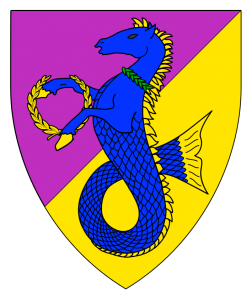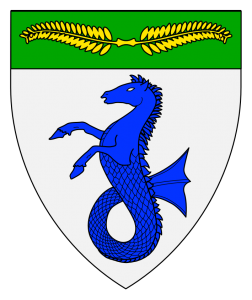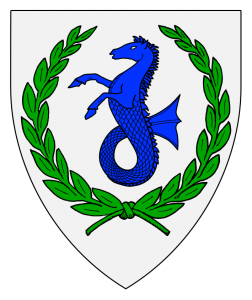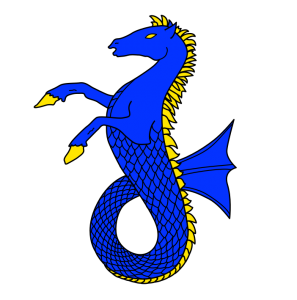In addition to the primary branch armory, Østgarðr has also registered badges corresponding to several orders and awards of honor.

A natural sea-horse proper.
This badge was registered in June 1975. (View submitted image.)
The blazon was initially approved as “a seahorse (hippocampus) proper”; the phrasing was changed to “a natural sea-horse proper” at a later date.
This registration has been the subject of some discussion because the only record of the submission is monochrome and lacks tricking marks that would tell us which colors were to be used, and nobody knows for sure what color a “proper” natural seahorse is meant to be — real seahorses come in a variety of colors including brown, yellow, red, blue, green, and purple, as well as striped and multicolor patterns.
(There may have been a color copy of this submission that has since been lost, but I suspect it was actually submitted only in black and white, as were the other registrations from Østgarðr during the 1970s, and was registered despite the policy issued in June 1972 that submissions “MUST be accompanied by an emblazon in full colour.”)
The online armory lists this is being for “an award of honor: purple ribbon for arts, gold for outstanding service”. This is the only such listing I could find in the armory; all other badges with designations include the name of an order or award or guild or the like.
Order of the Seahorse
This order was registered in April 1981 [actually, in 1975 — see note below] and does not have an associated badge in the Society’s armory. (Although the Armory lists it as registered in April 1981, it does not appear on that month’s LOAR.)
Update, March 2017: Thanks to the Laurel Archivist, Baroness Shauna of Carrick Point, for filling in some background here — it turns out that the cover letter for the April ’81 LoAR describes the procedures for registering the name of orders and awards, and mentions a list of all previously-reported awards, titles, and orders which were grandfathered at that time. Therefore the dating of the Order of the Seahorse to April 1981 merely indicates that it was instituted some time before this; most likely around the same time as the badge above was registered. The Order of Precedence shows the first members of the Order received that honor in June 1975.
The Bylaws describe it thusly: “The Order of the Seahorse is granted by the Viceregency to those citizens of the Province who have distinguished themselves in the arts or to those persons who have served Østgarðr whether resident or not.”
The description of the Order of the Seahorse matches the “arts or service” intent of the “natural sea-horse proper” award listed above, but it is not formally linked to it in the armory records. In recent years it has been said that there is no fixed appearance of the award for the Order of the Seahorse, and instead each recipient is allowed to choose its form for themselves, which may result from an attempt to interpret the vague blazon of the above badge.

Order of the Sea Dog of Østgarðr
A sea-dog rampant azure, finned Or.
This order was registered in April 2008, and the badge was registered in August 2008. (View submitted image. See OSCAR for discussion of name and badge.)
The Bylaws describe it thusly: “The Order of the Seadog is granted by the Viceregency to citizens for service at the Canton level.”

Order of the Silver Sea-Lion
Vert, in pale three sea-lions passant argent.
This order was registered in October 2012, and the badge was registered in January 2012. (View submitted image. See OSCAR for discussion of name and badge. The order name was submitted at the same time as the badge, but returned for conflict; following passage of the new SENA rules, the original name was re-submitted and accepted.)

Order of the Silver Lantern
On a mullet vert a lantern argent.
This order was registered in July 2012, and the badge was registered in December 2013. (View submitted image. See OSCAR for discussion of name and badge. The badge was originally submitted in 2012 as a lantern argent, but returned at Kingdom for conflict; the version shown here was submitted the following year.)

Award of the Sea Star of Østgarðr
An estoile of five rays argent.
This award and badge were registered in April 2014, but their use dates back to at least a decade earlier, as they were given during the reign of Ian and Katherine. (View submitted image. See OSCAR for discussion of name and badge.)
The Bylaws describe it as “The Honor of the Sea Star: Bestowed by the Viceregency upon individuals who have, on a particular occasion, served the Province well and ‘made things happen.’”
 Gules, in saltire a claymore and a rose slipped and leaved, and in chief a robin argent.
Gules, in saltire a claymore and a rose slipped and leaved, and in chief a robin argent.

















